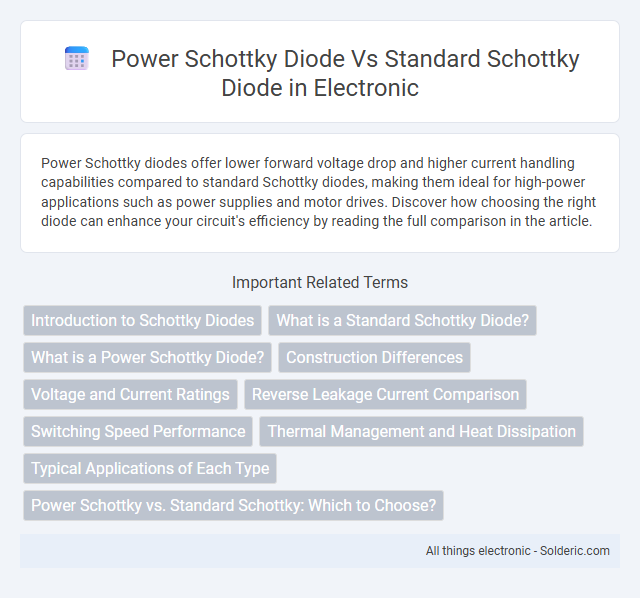Power Schottky diodes offer lower forward voltage drop and higher current handling capabilities compared to standard Schottky diodes, making them ideal for high-power applications such as power supplies and motor drives. Discover how choosing the right diode can enhance your circuit's efficiency by reading the full comparison in the article.
Comparison Table
| Feature | Power Schottky Diode | Standard Schottky Diode |
|---|---|---|
| Current Rating | High (up to several hundred amperes) | Low to Moderate (up to tens of amperes) |
| Voltage Rating | Medium to High (typically 40V - 200V) | Low to Medium (typically 20V - 100V) |
| Forward Voltage Drop (Vf) | Low (approx. 0.3V - 0.45V) | Lower (approx. 0.15V - 0.4V) |
| Reverse Recovery Time | Ultra-fast (nanoseconds) | Ultra-fast (nanoseconds) |
| Application | High power switching, rectifiers, power supplies | Low power switching, RF applications, voltage clamping |
| Package | Robust, heavy-duty packages (TO-247, TO-220) | Smaller, compact packages (SMA, SMB, SOD-123) |
Introduction to Schottky Diodes
Schottky diodes are semiconductor devices known for their low forward voltage drop and fast switching speed, making them ideal for high-efficiency power applications. Power Schottky diodes are designed to handle higher current and voltage levels compared to standard Schottky diodes, which are typically used in low-power circuits. Understanding the distinction between power and standard Schottky diodes helps optimize your circuit performance in terms of energy efficiency and thermal management.
What is a Standard Schottky Diode?
A Standard Schottky diode is a semiconductor device characterized by its metal-semiconductor junction, which enables fast switching speeds and low forward voltage drop, typically around 0.3 to 0.4 volts. It is widely used in high-frequency applications and power rectification due to its efficient conduction and reduced power loss compared to traditional PN junction diodes. Unlike Power Schottky diodes, standard types handle lower currents and voltages, making them suitable for signal-level and low-power circuits.
What is a Power Schottky Diode?
A Power Schottky diode is a high-current, high-voltage semiconductor device designed to efficiently handle power rectification with low forward voltage drop and fast switching speeds. Unlike standard Schottky diodes, Power Schottky diodes are optimized for applications in power supplies, automotive electronics, and high-frequency power conversion, offering enhanced thermal stability and higher surge current capabilities. These diodes utilize a metal-semiconductor junction to minimize conduction losses, improving overall energy efficiency in power management systems.
Construction Differences
Power Schottky diodes feature larger die sizes and enhanced metallization patterns compared to standard Schottky diodes, enabling higher current handling and improved thermal performance. The epitaxial layer in power Schottky diodes is optimized for lower forward voltage drop and reduced junction capacitance, which differs from the thinner, less robust design of standard Schottky diodes. Advanced packaging and heat dissipation structures in power Schottky diodes further distinguish their construction by ensuring greater reliability in high-power switching applications.
Voltage and Current Ratings
Power Schottky diodes typically offer higher voltage and current ratings than standard Schottky diodes, making them suitable for demanding power applications. Your choice should consider that power versions can handle increased forward current and withstand higher reverse voltages, often exceeding 100V and several amps. Standard Schottky diodes are generally optimized for low forward voltage drops but have lower maximum voltage and current limits.
Reverse Leakage Current Comparison
Power Schottky diodes exhibit significantly lower reverse leakage current compared to standard Schottky diodes, enhancing their efficiency in high-temperature and high-voltage applications. The reduced leakage current in power Schottky diodes minimizes power loss and heat generation, making them ideal for power rectification in industrial and automotive circuits. Standard Schottky diodes typically have higher reverse leakage current, which can lead to increased power dissipation and reduced reliability under stress conditions.
Switching Speed Performance
Power Schottky diodes demonstrate significantly faster switching speeds compared to standard Schottky diodes, owing to their optimized junction design and reduced charge storage effects. The lower forward voltage drop and minimal reverse recovery time in power variants enhance performance in high-frequency applications such as power converters and RF circuits. These improvements directly translate into higher efficiency and reduced switching losses in electronic systems demanding rapid response times.
Thermal Management and Heat Dissipation
Power Schottky diodes feature enhanced thermal management capabilities due to their larger die size and improved junction-to-case thermal resistance, enabling efficient heat dissipation under high current conditions. Standard Schottky diodes typically have higher thermal resistance and lower maximum junction temperature ratings, limiting their performance in applications with significant thermal loads. Optimizing heat sinks and thermal interface materials is crucial for Power Schottky diodes to maintain reliability and prevent thermal runaway in power electronics systems.
Typical Applications of Each Type
Power Schottky diodes are commonly used in high-current applications such as power supplies, DC-DC converters, and solar inverters due to their low forward voltage drop and fast switching capabilities. Standard Schottky diodes are typically found in high-frequency circuits, RF applications, and voltage clamping because of their low capacitance and fast response time. Each type is optimized for different performance criteria, making power Schottky diodes ideal for energy efficiency and thermal management, while standard Schottky diodes excel in signal integrity and noise reduction.
Power Schottky vs. Standard Schottky: Which to Choose?
Power Schottky diodes offer lower forward voltage drop and higher current handling capacity compared to standard Schottky diodes, making them ideal for high-power applications such as power supplies and DC-DC converters. Standard Schottky diodes excel in low-voltage, high-speed switching due to their fast recovery time and lower junction capacitance, suitable for signal rectification and protection circuits. Choosing between them depends on the specific requirements of current load, efficiency, and thermal performance in the intended electronic design.
Power Schottky diode vs Standard Schottky diode Infographic

 solderic.com
solderic.com